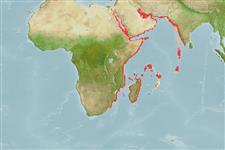>
Eupercaria/misc (Various families in series Eupercaria) >
Lutjanidae (Snappers) > Lutjaninae
Etymology: Lutjanus: Malay, ikan lutjan, name of a fish.
More on author: Cuvier.
Environment: milieu / Zona climática / intervalo de profundidade / distribution range
Ecologia
marinhas associadas(os) a recifes; intervalo de profundidade 9 - 150 m (Ref. 9710). Tropical; 31°N - 30°S, 30°E - 77°E (Ref. 55)
Western Indian Ocean: Red Sea east to the Arabian Sea and south to Natal, South Africa. Records of this species from the eastern Indian Ocean and the Western Central Pacific are probably misidentifications of Lutjanus malabaricus (Ref. 55). Has been misidentified as Lutjanus coccineus by recent authors.
Comprimento de primeira maturação / Tamanho / Peso / Idade
Maturidade: Lm 51.1, range 50 - 60 cm
Max length : 100.0 cm TL macho/indeterminado; (Ref. 9710); common length : 70.0 cm TL macho/indeterminado; (Ref. 5450); peso máx. publicado: 23.0 kg (Ref. 469); idade máx. registrada: 13 anos (Ref. 1488)
Espinhos dorsais (total) : 10; Raios dorsais (total) : 13 - 14; Espinhos anais: 3; Raios anais : 8 - 9. Dorsal profile of head angular, snout steeply sloped. Preorbital bone broad, with horizontal grooves behind and below the eye. Anterior and posterior nostrils widely spaced. Preopercular notch and knob poorly developed. Scale rows on back rising obliquely above lateral line. Juveniles with a broad brown bar from upper jaw to beginning of dorsal fin and a series of reddish horizontal lines on sides.
Body shape (shape guide): fusiform / normal; Cross section: oval.
Adults inhabit coral and rocky reefs to depths of at least 100 m (Ref. 30573). Off South Africa they display a preference for slightly silty, turbid regions in the vicinity of sometimes shallow, offshore banks. Captured mainly at night on coral banks off Mafia Island (Tanzania) in 9 to 12 m and off Zanzibar in about 75 m. They are active at night feeding over sandy or rubble bottoms (Ref. 9710). Maximum depth reported taken from Ref. 9773.
Allen, G.R., 1985. FAO Species Catalogue. Vol. 6. Snappers of the world. An annotated and illustrated catalogue of lutjanid species known to date. FAO Fish. Synop. 125(6):208 p. Rome: FAO. (Ref. 55)
Status na Lista Vermelha da UICN (Ref. 130435: Version 2025-1)
Ameaça para os humanos
Harmless
Uso pelos humanos
Pescarias: altamente comercial; peixe esportivo: sim; Aquário: Espécies comerciais
Ferramentas
Relatórios especiais
Baixar XML
Fontes da internet
Estimates based on models
Preferred temperature (Ref.
123201): 23.4 - 29.2, mean 26.8 °C (based on 328 cells).
Índice de diversidade filogenética (Ref.
82804): PD
50 = 0.5000 [Uniqueness, from 0.5 = low to 2.0 = high].
Bayesian length-weight: a=0.01445 (0.00826 - 0.02530), b=2.96 (2.81 - 3.11), in cm total length, based on LWR estimates for this species & Genus-body shape (Ref.
93245).
Nível Trófico (Ref.
69278): 4.5 ±0.7 se; based on diet studies.
Resiliência (Ref.
120179): Baixo, tempo mínimo de duplicação da população 4,5 - 14 anos (K=0.24; tm=2.5-6; tmax=13).
Fishing Vulnerability (Ref.
59153): Moderate vulnerability (39 of 100).
🛈
Nutrients (Ref.
124155): Calcium = 20.1 [12.1, 30.3] mg/100g; Iron = 0.298 [0.190, 0.484] mg/100g; Protein = 18.6 [17.1, 19.9] %; Omega3 = 0.126 [0.086, 0.186] g/100g; Selenium = 74.5 [44.1, 119.9] μg/100g; VitaminA = 173 [33, 695] μg/100g; Zinc = 0.311 [0.241, 0.432] mg/100g (wet weight);
